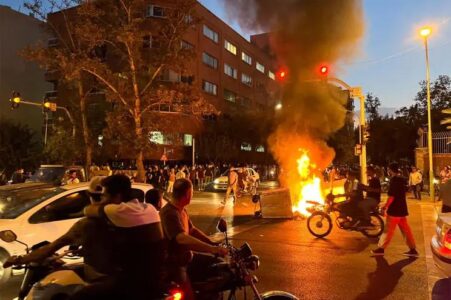
Iran Regime Brings in Terror Proxies to Quash Protests
With Iran entering its fifth week of protests over the death of 22-year-old Mahsa Amini, new reports reveal that the Islamic Republic is deploying its terrorist proxies into the country to aid security forces in their crackdown on protesters. According to reports in Iran, Lebanese Hezbollah, and the Iraqi Has’d al-Shaabi have been seen helping the Islamic Basij paramilitary forces beat, arrest, and kill protesters throughout Iran.
Reports from the ground in Iran reveal that plain-clothes men speaking Lebanese-accented Arabic were attempting to suppress riots in various cities throughout the country, including in the nation’s capital of Tehran. These reinforcements are in addition to the hundreds of Islamic troops belonging to the Basij and the Islamic Revolutionary Guard Corps, who have been central in quashing the protests. Iran has been engulfed in widespread protests against the regime since mid-September after the death of 22-year-old Mahsa Amini, who was killed by the Islamic morality police over her hijab wear.
Since then, security forces have been overwhelmed throughout the country by protesters on the streets, neighborhoods, and universities, leading officials of the IRGC to deploy troops to prevent a full-scale revolution.
In October, Hezbollah Secretary-General Hassan Nasrallah commented on the death of Amini, calling it a “vague incident” and describing the ongoing protests in Iran as unreflective of the “true will” of Iranians.
“The Iranian state is a target, and so any incident is exploited to incite against this state,” said Nasrallah. “This vague incident was exploited, and people took to the streets.”
In Syria, the officials from the Assad regime stated that the country stands with the Islamic Republic and emphasized that regime change will not occur in Tehran.
The use of terrorist proxies to quell protests in Iran is nothing new for the Islamic regime, given the longstanding history that dates back to the 1979 revolution. During the Islamic Revolution, Shiite Islamists from Lebanon and Palestinian terrorist fighters were in Iran, helping Ayatollah Khomeini and his supporters overthrow the Shah and establish the new Islamic government. After the revolution, Iran invested its economic and military resources into radical Islamic terrorist organizations, supporting Hezbollah in Lebanon, Hamas and Palestinian Islamic Jihad in the Gaza Strip and more recently the West Bank, the Houthis in Yemen, and various Shiite Islamic groups in Iraq.
During the 2009 Green Revolution in Iran, many reports indicated that riot police and plain-clothes officers with Arabic accents were seen cracking down on Iranians who were demonstrating against the results of the presidential election. Many believe that the men in police uniforms were from Hezbollah or other Islamic terrorist groups like Hamas, who came directly from Lebanon and Gaza.
According to Iranian experts, these groups rely heavily on the Islamic Republic and cannot live without financial and military aid from the IRGC.
Should the Islamic Republic be overthrown, Islamic terrorist groups will lose critical support. Whenever protests have broken out in Iran among student groups and ordinary citizens, officials from Iranian-backed groups immediately come out with statements supporting the Ayatollahs and their rule, offering to send assistance to help crackdown on what they describe as protests backed by “foreign services.”
Despite the economic hardships that Iran continues to face, the regime continues to send billions of dollars to its proxies to attack American-backed forces in the Middle East and Israel. The government continues to supply its Islamic affiliates with up-to-date technology such as drones, ammunition, rockets, and training to spread the Islamic Revolution throughout the region and the world.
Source: Foreigndesknews





